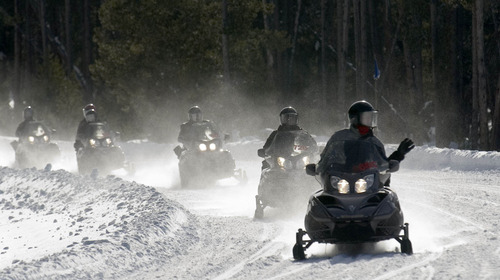This is an archived article that was published on sltrib.com in 2013, and information in the article may be outdated. It is provided only for personal research purposes and may not be reprinted.
Conservation groups concerned about the impacts of winter travel on wildlife and the quality of visitor experiences in Yellowstone National Park are "mostly" supporting a winter use plan released Friday by the National Park Service.
Yellowstone National Park Superintendent Dan Wenk said in an interview with The Salt Lake Tribune Thursday that the proposed plan, which is to open soon for a 60-day comment period, is a different approach from previous plans.
"This plan is based on winter travel events rather than one snowcoach or one snowmobile," Wenk said. "This alternative is primarily about protecting park resources and the values the American public holds dear. There are also elements of this plan which appeal to commercial operators. We feel it addresses the concerns of all the stakeholders."
Under the proposed plan, Yellowstone National Park would allow as many as 110 "transportation events" each day. An event is defined as either one snowcoach or an average group of seven snowmobiles. No more than 50 transportation events each day would be allocated for snowmobiles.
"The park's proposed plan and the superintendent's commitments to its core elements are big steps in assuring Yellowstone's conservation and the enjoyment of visitors," said Mark Pearson, conservation program director for the Greater Yellowstone Coalition. "Yellowstone had lost control over snowmobile use by the 1990s and it has taken over a decade for our first national park to restore the healthier winter conditions now benefitting visitors and wildlife. Many visitors now come to Yellowstone in winter because of opportunities to experience and learn about its wonders without intrusive exhaust and commotion."
The plan, which would not be applied until the 2014-15 season if passed, would also allow one entry a day per entrance for a non-commercially guided group of up to five snowmobiles. All other snowmobile riders would be required to be with a commercial guide.
"Required guiding in many ways has solved the wildlife harassment issues," Wenk said. "But this plan recognizes that some people want to go without a guide. If you and a group of four others with Best Available Technology (BAT) compliant machines took a training course and met with a ranger, you could enter the park without a guide. This is similar to private trips allowed on many of the rivers."
A collection of conservation groups, including the Greater Yellowstone Coalition, National Parks Conservation Association, Winter Wildlands Alliance, Sierra Club, and Natural Resources Defense Council, put support behind the proposed plan in a prepared release, but had a couple of concerns.
The groups called the plan to allow snowmobile groups into the park without professional guides "a step in the wrong direction."
They also took exception to the National Park Service's proposal to continue allowing motorized travel on the East Entrance road and over Sylvan Pass.
The groups say the effort to keep the East Entrance road open and safe from possible avalanches is too expensive, $125,000 annually according to the release, for the low number of visitors that use the access — 110 visitors in 2011-12.
Avalanche control on Sylvan Pass, they say, is dangerous for park employees and intrusive on sensitive wildlife like wolverine and lynx due to the use of artillery shelling.
Comments on the Yellowstone Winter Use Plan will be considered when a final recommendation is presented. The National Park Service is expected to release a Record of Decision sometime this spring.
Twitter @BrettPrettyman —
Yellowstone Winter Use Plan
O The National Park Service released the final Winter Use Plan for Yellowstone National Park on Friday. A copy of the plan is available at bit.ly/13u6PZs. A 60-day public review and comment period on the proposal is expected to open soon.





